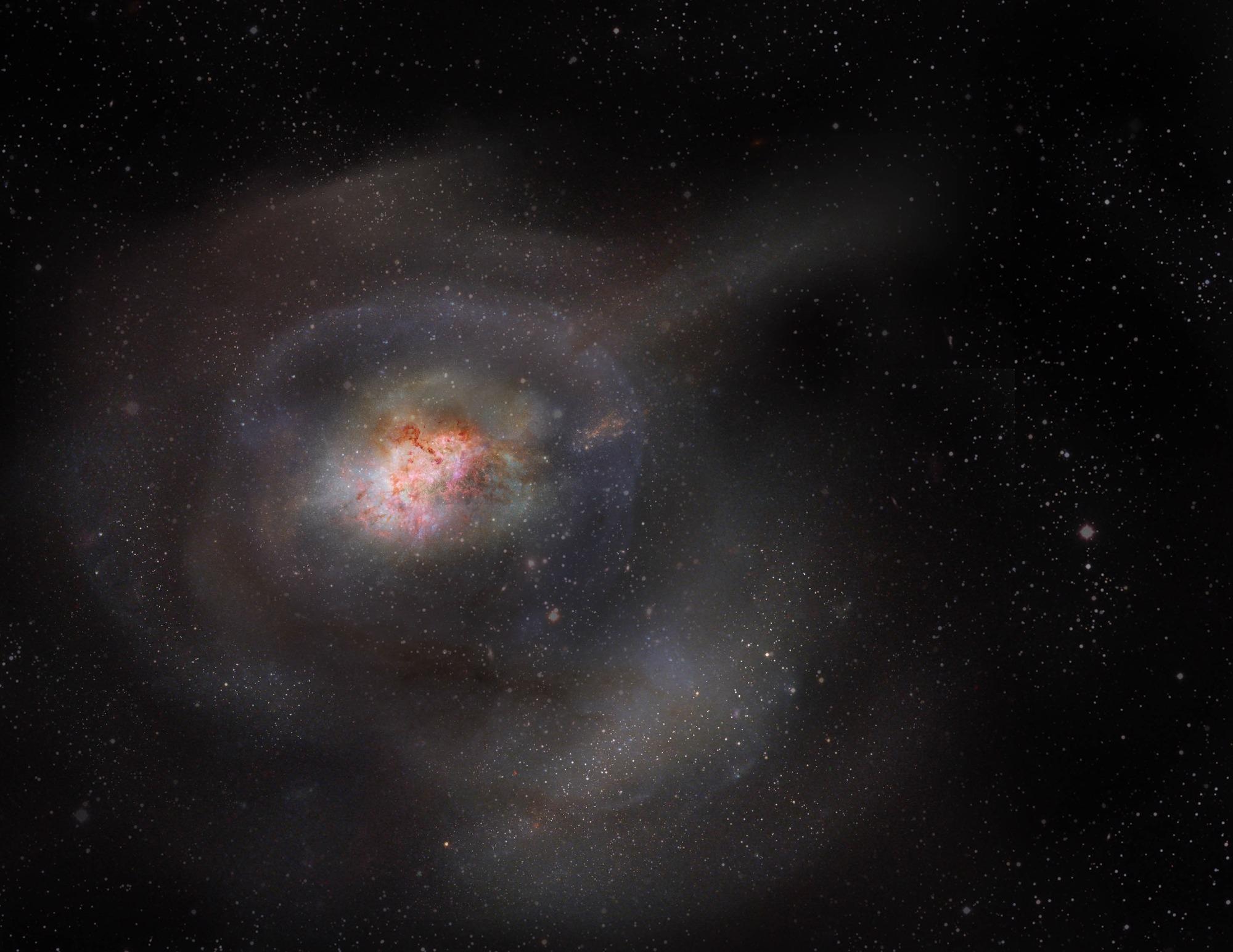Earlier, it was thought that post-starburst galaxies scatter all of their gas and dust — the fuel needed to create new stars — in violent bursts of energy, and at incredible speeds.
 Post-starburst galaxies or PSBs, were previously thought to expel all of their gas in violent outbursts, leading to quiescence, a time when galaxies stop forming stars. But scientists using the Atacama Large Millimeter/submillimeter Array (ALMA) found that instead, PSBs condense and hold onto this turbulent gas, and then don’t use it to form stars. This artist’s impression highlights the compactness of molecular gas in a PSB and its lack of star formation. Image Credit: ALMA (ESO/NAOJ/NRAO)/S. Dagnello (NRAO/AUI/NSF)
Post-starburst galaxies or PSBs, were previously thought to expel all of their gas in violent outbursts, leading to quiescence, a time when galaxies stop forming stars. But scientists using the Atacama Large Millimeter/submillimeter Array (ALMA) found that instead, PSBs condense and hold onto this turbulent gas, and then don’t use it to form stars. This artist’s impression highlights the compactness of molecular gas in a PSB and its lack of star formation. Image Credit: ALMA (ESO/NAOJ/NRAO)/S. Dagnello (NRAO/AUI/NSF)
According to new information from the Atacama Large Millimeter/submillimeter Array (ALMA), these galaxies do not scatter all of their star-forming fuel after all. Instead, these dormant galaxies retain and condense large amounts of highly concentrated, turbulent gas after their supposed end. But, contrary to popular belief, they are not using it to create stars.
In most galaxies, investigators expect the gas to be distributed in a similar way to starlight. However, this is not the case for post-starburst galaxies or PSBs. PSBs differ from other galaxies in that they form as a result of violent collisions or mergers between galaxies. Galaxy mergers usually result in massive bursts of star formation, but in PSBs, this outburst decelerates and nearly stops as soon as it starts.
As a result, researchers previously thought that the central star-forming factories of these galaxies had little or no star-forming fuel left. Until now, it was thought that the molecular gases had been redistributed to radii far beyond the galaxies, either through stellar processes or through black hole effects. The new findings challenge this theory.
We’ve known for some time that large amounts of molecular gas remains in the vicinity of PSBs but haven’t been able to say where, which in turn, has prevented us from understanding why these galaxies stopped forming stars. Now, we have discovered a considerable amount of remaining gas within the galaxies and that remaining gas is very compact.
Adam Smercina, Study Principal Investigator and Astronomer, University of Washington
Smercina adds, “While this compact gas should be forming stars efficiently, it isn’t. In fact, it is less than 10-percent as efficient as similarly compact gas is expected to be.”
Along with being compact enough to produce stars, the gas in the identified dormant — or quiescent — galaxies had another surprise in store for the group: it was frequently centrally located, if not always, and was astonishingly turbulent. Scientists were left with more questions than answers as a result of these two characteristics when combined.
Adam Smercina states, “The rates of star formation in the PSBs we observed are much lower than in other galaxies, even though there appears to be plenty of fuel to sustain the process. In this case, star formation may be suppressed due to turbulence in the gas, much like a strong wind can suppress a fire.”
“However, star formation can also be enhanced by turbulence, just like wind can fan flames, so understanding what is generating this turbulent energy, and how exactly it is contributing to dormancy, is a remaining question of this work,” added Adam Smercina.
These results raise the question of what energy sources are present in these galaxies to drive turbulence and prevent the gas from forming new stars. One possibility is energy from the accretion disk of the central supermassive black holes in these galaxies.
Decker French, Study Co-Author and Astronomer, University of Illinois
Comprehending the processes that control the formation of stars and galaxies is essential for putting the Universe and its place in it into context. The finding of turbulent, compact gas in otherwise dormant galaxies provides astronomers with yet another clue to the mystery of how galaxies live, evolve and die over billions of years.
This implies that more future research will be possible thanks to ALMA’s 1.3 mm receiver, which sees what would otherwise be invisible with stunning clarity.
There is much about the evolution of a typical galaxy we don’t understand, and the transition from their vibrant star-forming lives into quiescence is one of the least understood periods. Although post-starbursts were very common in the early Universe, today they are quite rare.
J. D. Smith, Study Co-Author and Astronomer, University of Toledo
J. D. Smith remarks, “This means the nearest examples are still hundreds of millions of light-years away, but these events foreshadow the potential outcome of a collision, or merger, between the Milky Way Galaxy and the Andromeda Galaxy several billion years from now. Only with the incredible resolving power of ALMA could we peer deep into the molecular reservoirs left behind ‘after the fall.’”
“It’s often the case that we as astronomers intuit the answers to our own questions ahead of observations, but this time, we learned something completely unexpected about the Universe,” concluded Smercina.
Journal Reference:
Smercina, A., et al. (2022) After The Fall: Resolving the Molecular Gas in Post-Starburst Galaxies. The Astrophysical Journal. doi.org/10.3847/1538-4357/ac5d5f.